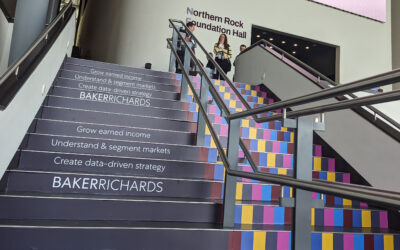Dynamic pricing on trial: guilty or not guilty?
The defendant is brought up from the cells – the once unblemished, unassailable golden child of an entire live entertainment industry. Onlookers are shocked that all may not be as it first appeared.
“Will the defendant please stand, and state your name?” There comes a reluctant, muttered reply: “Dynamic Pricing”. “And your address?” This time the figure in the dock speaks up, asserting with confidence: “You’ll find me pretty much everywhere”. Which is, of course, true.
In a mock trial at this year’s Ticketing Professionals Conference, I charged Dynamic Pricing with “ultimately doing more harm than good to arts and culture”. The format was a conceit to kick the tyres on the questions many clients are asking Baker Richards in the context of the pandemic fallout and the rising cost of living.
With recent research into missing audiences suggesting some theatres – particularly those in the mid-scale – could see a 35% drop in ticket sales over the next year or two, attention is turning more urgently to how to build up audience numbers.
The case for the prosecution
Speaking to several hundred ‘jurors’ at that mock trial held in Birmingham, I rose for the prosecution to argue that dynamic pricing makes arts and culture too expensive. That it is the enemy of diversity and inclusion. That it is a distraction from other, better things. That it causes long term harm to the industry. The antithesis of audience growth.
What the sector calls dynamic pricing isn’t actually dynamic at all. This euphemism serves to denote respectability and attractiveness. Things that are dynamic are good! Things that are dynamic are modern!
Were we to call it what it really is – Inflationary Pricing, Venue-Controlled Adjustable Pricing, or Opaque Pricing… Well those names don’t sit well with organisations who think of themselves as audience-centred.
The case put by the prosecution was that dynamic pricing is driven by cynicism. If people want something enough, they will pay. But some people can’t afford high ticket prices. Fact. So high prices exclude some audiences. Also fact. Yet the degree of denial about these facts – even in our industry which prides itself on accessibility – is high.
Case closed?
The case for the defence
Perhaps confusingly for the jurors, and certainly unconventionally even for a mock court, I rose again, this time for the defence.
In the first instance, I wanted to debunk the notion that a dynamic price is an inherently opaque pricing practice. Had the prosecutor not heard of “book early for the best prices”? Six words found on pretty much any ticketing website or brochure in the land. If there were any clearer clue to the possibility that prices might rise, it would be hard to imagine.
Rather than identifying groups of people for concessionary rates according to innate characteristics – age or physical ability for example – dynamic pricing simply offers the best available price daily to all customers. In that respect, it is a great leveller. Why should a 25-year-old earning a decent wage benefit from a standard concession, when a 27-year-old on Universal Credit does not?
As defence advocate, I reached for evidence of the growth of audiences from data collected by Baker Richards and the Audience Agency. Total audiences for UK subsidised arts grew 3.7% in the two years before the pandemic. Income rose 10.8%. These are hallmarks of a successful industry.
And what are the alternatives? To try to increase income from bar sales and merchandise? The return on investment would be far less than simply tweaking the face value of tickets.
As the resale market often shows ticket value to be substantially above the original face price, the defence closed with a quote in justification of dynamic pricing from the President of the Shubert Organisation: “At least the people who do the work and took the risk are getting some benefits.” If audiences are going to shrink, better to maximise the yield from those who are willing to pay.
Arbitration
At the Ticketing Professionals Conference, I could indulge in an adversarial exercise to highlight the case for and against dynamic pricing. Usually, my job is to illuminate or even arbitrate from a steadfastly neutral position – we always advise based on an organisation’s individual circumstances.
With the pincer movement of the pandemic and the rising cost of living, cultural organisations want more considered approaches to pricing. Not only “how can we make more money as costs rise and funding falls in real terms?”, but also “how can we be sustainable and accessible, as well as commercially successful?”.
According to the Office for Budget Responsibility, the next year or two will feel like a recession to many. And indeed, a recession may be on the way. Previous experience suggests the average frequency of attendance at cultural events will drop as a consequence. A good strategic response is to focus on maximising audience volume for medium- and long-term recovery, keeping people in, and getting people into, the habit of cultural attendance as much as possible.
Where demand is high, dynamic pricing will be the right approach for many. But for those with budgets bolstered by multiple income sources, this may be the time to offer a range of prices which don’t change once set, and to make a virtue of doing so.
There is also ‘radical pricing’ to consider, in which alongside paying a standard price, patrons can choose to pay it forward to help another, or to access an open concession. Interest in this approach has been steadily growing.
Prices and pricing strategies communicate much about an organisation’s values and its attitude to audiences. Getting it wrong can undo even the most carefully crafted brand messaging. Price alone does not build audiences – wise organisations will continue to invest in their marketing and engagement teams.
The verdict
Back then, to Birmingham. How did Dynamic Pricing fare in our mock trial? According to the jurors, NOT guilty of doing more harm than good to arts and culture, by two to one. Stripped of any shades of grey, it walked away from the Ticketing Professionals Conference innocent. What would be your verdict?




